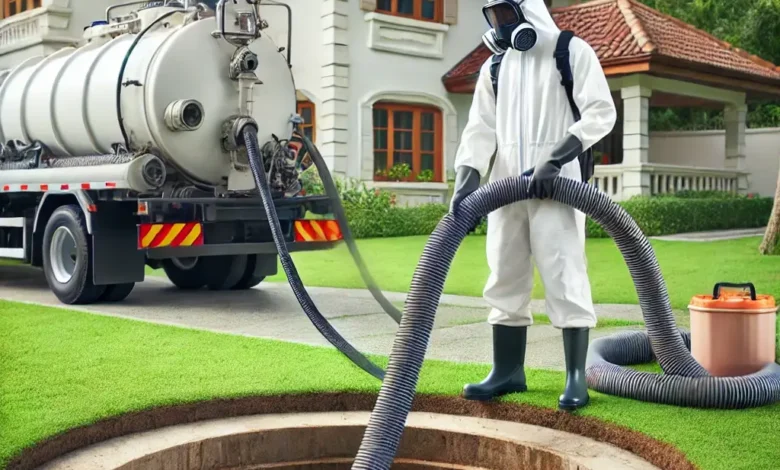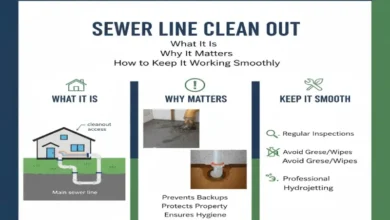Septic Tank Cleaning: A Vital Part of Home Maintenance

Septic tanks play a important part in ensuring the proper management of wastewater for businesses and homes that aren’t connected to sewage systems in municipal systems. A regular cleaning of septic tanks is required to ensure the systems are functioning properly and to avoid expensive repairs and environmental damages. In this piece, we’ll discuss the reasons why cleaning your septic tank is essential, when it’s necessary, and what the ideal practices are for maintaining a healthy septic system.
Why is Septic Tank Cleaning Important?
The purpose of a septic tank is to remove solids from the wastewater and permit the wastewater to pass through the soil. As time passes, sludge and scum can build up inside the tank and may reduce the effectiveness of the tank. If uncontrolled, it can lead to blocks, system malfunctions, and unattractive odors. Regularly cleaning will ensure that the system is operating effectively and help prevent issues such as:
- Backups and Overflows Septic tanks that are blocked may cause the water to flow back into your house or your yard, which can lead to unhealthy situations.
- The system is damaged: Buildup of solids could cause the tank as well as the drain field to become damaged, which can lead to costly repair.
- Health Risks Septic tanks that are not properly maintained could release toxic bacteria into the air, contaminate the groundwater, and cause health problems.
How Often Should a Septic Tank Be Cleaned?
The frequency of cleaning septic tanks will depend on many variables, like the capacity of the tank, how many people use it, and also the type of waste to be disposed of. In general, septic tanks are cleaned once every three to five years. But if your house generates a lot of waste, or your system shows symptoms of issues, it may be necessary to maintain it on a regular basis.
These are some indications that your septic system may be in need of cleaning more quickly:
- Slow Drains If the drains in your home are slow or the water is leaking within the toilet, sink, or tub, it could indicate the tank being full.
- unpleasant odors Odors of foul odors that are present on your property, in particular around the drain field. These could indicate that the tank isn’t working properly.
- The lush grass or pooling water: Excessively green grass or standing water that is visible over the drain area could indicate that water has escaped from the tank.
The Septic Tank Cleaning Process
Septic tank maintenance is the process of pumping out liquids, solids, and the sludge that have accumulated within the tank. The following is an outline of what’s involved.
1. Inspection
The initial step is to examine the septic system. An experienced technician will evaluate the condition of the tank, search for blockages, and then determine if the system requires repair or cleaning.
2. Pumping
After that, the technician will utilize a vacuum to eliminate the build-up in the form of sludge, scum, or waste out of the tank. This helps eliminate any obstructions and also ensures the tank functions properly.
3. Cleaning the Tank
When the tank is empty and cleaned, the tank is then cleaned to get rid of any particles. This could include flushing the tank using water until it’s totally clean.
4. Disposal of Waste
The sewage that’s collected from the septic tanks is then transported to an approved treatment facility, which is then properly treated and removed according to the environmental guidelines.
Tips for Maintaining a Healthy Septic Tank
Apart from regular maintenance, there are a variety of ways you can increase the longevity of your septic system.
1. Avoid Flushing Non-Biodegradable Items
Avoid flushing items such as diapers, wipes, and chemical products down the toilet. They can block the septic tank and lead to blockages.
2. Conserve Water
Overuse of water can strain the septic tank. Repair leaks, install low-flow faucets, and stay clear of using multiple sources of water in parallel to ease the pressure on the system.
3. Use Septic-Friendly Products
Utilize biodegradable, safe septic cleaners and soaps to keep harmful chemicals out of the system.
4. Avoid Harsh Chemicals
Chemicals such as bleach, drain cleaners, and solvents could alter the balance between bacteria within the septic tank. It is essential to break down waste.
5. Maintain the Drain Field
Make sure the area around the drain field is free of large machinery, big trees, and other obstructions. These could cause harm to the system and stop the system from draining correctly.
Conclusion
The cleaning of your septic tank is a crucial component of maintaining your home. Cleaning regularly ensures that the system is operating effectively and avoids expensive repairs. Following the recommended routine of cleaning and applying the correct maintenance techniques, you will extend the lifespan of your system’s septic and prevent costly problems. Make sure to consult with a professional regarding clean-up and inspections in order to protect the safety that your tank is in, as well as the security of your home.
Also Read: Roof Cleaning Services: Professional Cleaning Can Extend Your Roof’s Lifespan

